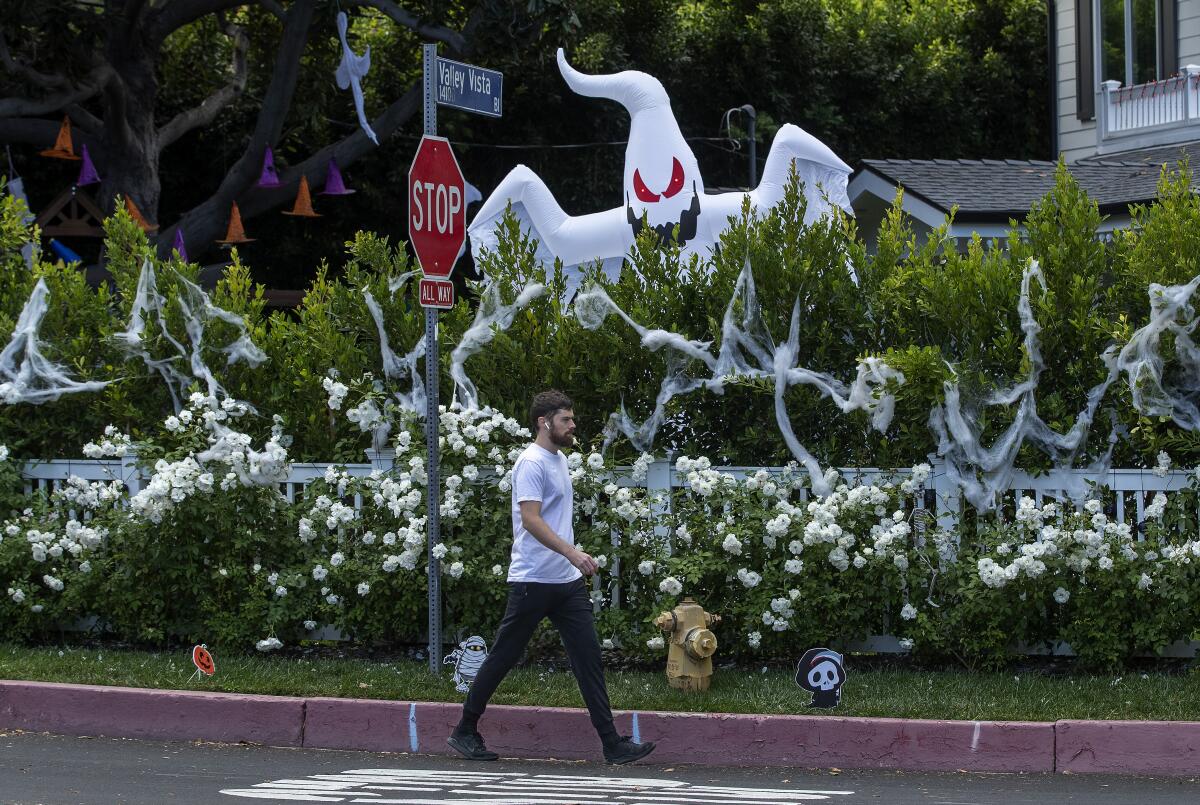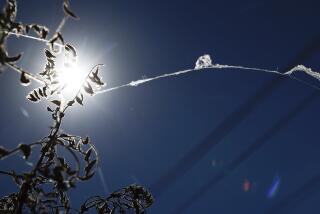Fake Halloween spiderwebs are truly scary — to wildlife

- Share via
Angelenos love Halloween. Every year as the days start to get noticeably shorter, disembodied hands erupt from flower beds and grinning skeletons settle in to lounge on front lawns. Witches, demons and ghouls pop up on rooftops and fences, and ghosts appear hanging from tree boughs.
This creepy decor is all in good fun, of course. The blood, guts and blades are phony and not intended to truly frighten people. But the reality is that, at least for our nonhuman neighbors, some of these decorations can be terrifying.
How? Imagine you are a hummingbird, flitting around a lovely native-plant-filled yard sipping nectar and gobbling up insects. You stop on a tree branch to rest your tiny wings, but the branches are festooned with sticky white fibers that don’t occur in nature. Your little feet get tangled in the durable threads — and you are stuck as surely as a fly in an orb weaver’s web. But instead of becoming a meal to some supersized arachnid, you die from starvation or constriction injuries sustained during your desperate struggle to get free. Talk about a real horror show!
Editorial: If we want wildlife to thrive in L.A., we have to share our neighborhoods with them
A proposed wildlife ordinance for L.A. is just what animal — and humans — need.
Sadly, wildlife rescuers report that this is a common occurrence during October, when unwitting humans stretch fake spider webbing along bushes, fences and trees. They may be man-made, but these pseudo-webs are strong and sticky, trapping critters as well as — or even better — than the spider-spun versions.
Alison Hermance at WildCare, a wildlife hospital and educational organization in the Bay Area, says that her group sees animals coming in tangled in fake spiderwebs this time of year and that a variety of animals are at risk, mostly birds but also possums, squirrels and even deer. Some years ago WildCare was called in to care for a screech owl that had become trapped in the faux webbing outside a house in Novato. Fortunately, the owl was freed and survived. But Hermance says that there’s likely all sorts of animals that aren’t so lucky and die without anyone noticing.
“Any time you’re putting something that is plastic and not a natural fiber in any shape or form ... into the environment, you are going to get animals tangled up in it,” Hermance said, noting that of all the holiday decorations, fake webs and string lights are the most perilous to wildlife.
This is particularly likely if the webs or lights are suspended across places that animals — wildlife and pets — regularly traverse. There are plenty of horrifying videos and stories found online of deer wrapped up in holiday string lights.
This is a good reminder that many of the things that humans thoughtlessly toss into the natural environment — plastic cups, straws and balloons, to name a few — can be death traps to wild animals, such as an unfortunate deer spotted roaming the Oakland Hills recently wrapped in what appears to be synthetic rope.
Editorial: Halloween’s scariest threats? Not razor blades or ‘rainbow’ fentanyl, but rumors and lies
Halloween myths of poisoned candy and child-molesting kidnappers may become even more evil in election season.
So consider this a public service announcement: Use fake Halloween spiderwebs with extreme caution. Don’t stretch them across animal pathways, and check them twice a day to make sure no critters are stuck. If you find a trapped animal in your yard or a neighbor’s, extract it and a good bit of webbing around it, and take it to the local wildlife rescue center for care (there are a bunch in the Greater L.A. area).
Or even better? Don’t use those fake webs at all. There are plenty of less-harmful spooky decoration options. They are, after all, just another single-use plastic product destined for the landfill. So even if they don’t entrap a bird or beast during their short seasonal life, they will have a long afterlife as microplastic, wreaking untold harm to the environment for decades to come. And that is truly scary.
More to Read
A cure for the common opinion
Get thought-provoking perspectives with our weekly newsletter.
You may occasionally receive promotional content from the Los Angeles Times.











